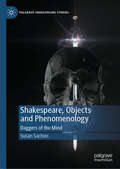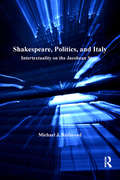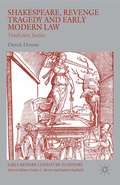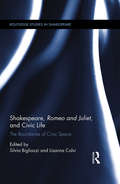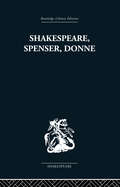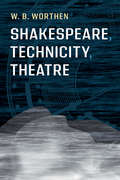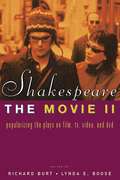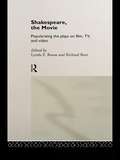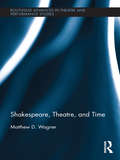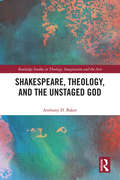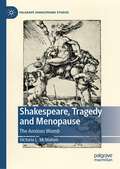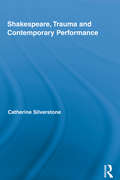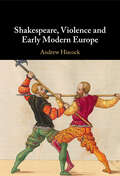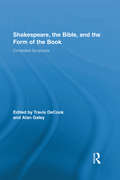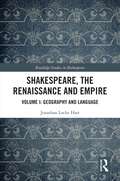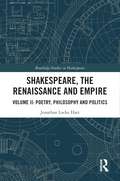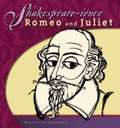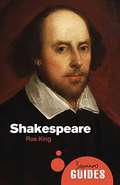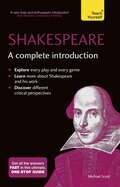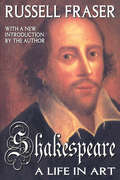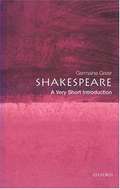- Table View
- List View
Shakespeare, Music and Performance
by David Lindley Bill BarclayMusic has been an essential constituent of Shakespeare's plays from the sixteenth century to the present day, yet its significance has often been overlooked or underplayed in the history of Shakespearean performance. Providing a long chronological sweep, this collection of essays traces the different uses of music in the theatre and in film from the days of the first Globe and Blackfriars to contemporary, global productions. With a unique concentration on the performance aspects of the subject, the volume offers a wide range of voices, from scholars to contemporary practitioners (including an interview with the critically acclaimed composer Stephen Warbeck), and thus provides a rich exploration of this fascinating history from diverse perspectives.
Shakespeare, Objects and Phenomenology: Daggers of the Mind (Palgrave Shakespeare Studies)
by Susan SachonThis book explores ways in which Shakespeare’s writing strategies shape our embodied perception of objects – both real and imaginary – in four of his plays. Taking the reader on a series of perceptual journeys, it engages in an exciting dialogue between the disciplines of phenomenology, cognitive studies, historicist research and modern acting techniques, in order to probe our sentient and intuitive responses to Shakespeare’s language. What happens when we encounter objects on page and stage; and how we can imagine that impact in performance? What influences might have shaped the language that created them; and what do they reveal about our response to what we see and hear? By placing objects under the phenomenological lens, and scrutinising them as vital conduits between lived experience and language, this book illuminates Shakespeare’s writing as a rich source for investigation into the way we think, feel and communicate as embodied beings.
Shakespeare, Politics, and Italy: Intertextuality on the Jacobean Stage (Anglo-Italian Renaissance Studies)
by Michael J. RedmondThe use of Italian culture in the Jacobean theatre was never an isolated gesture. In considering the ideological repercussions of references to Italy in prominent works by Shakespeare and his contemporaries, Michael J. Redmond argues that early modern intertextuality was a dynamic process of allusion, quotation, and revision. Beyond any individual narrative source, Redmond foregrounds the fundamental role of Italian textual precedents in the staging of domestic anxieties about state crisis, nationalism, and court intrigue. By focusing on the self-conscious, overt rehearsal of existing texts and genres, the book offers a new approach to the intertextual strategies of early modern English political drama. The pervasive circulation of Cinquecento political theorists like Machiavelli, Castiglione, and Guicciardini combined with recurrent English representations of Italy to ensure that the negotiation with previous writing formed an integral part of the dramatic agendas of period plays.
Shakespeare, Revenge Tragedy and Early Modern Law: Vindictive Justice (Early Modern Literature in History)
by Derek DunneThis book, the first to trace revenge tragedy's evolving dialogue with early modern law, draws on changing laws of evidence, food riots, piracy, and debates over royal prerogative. By taking the genre's legal potential seriously, it opens up the radical critique embedded in the revenge tragedies of Kyd, Shakespeare, Marston, Chettle and Middleton.
Shakespeare, Rhetoric and Cognition
by Raphael LyneRaphael Lyne addresses a crucial Shakespearean question: why do characters in the grip of emotional crises deliver such extraordinarily beautiful and ambitious speeches? How do they manage to be so inventive when they are perplexed? Their dense, complex, articulate speeches at intensely dramatic moments are often seen as psychological - they uncover and investigate inwardness, character and motivation - and as rhetorical - they involve heightened language, deploying recognisable techniques. Focusing on A Midsummer Night's Dream, Othello, Cymbeline and the Sonnets, Lyne explores both the psychological and rhetorical elements of Shakespeare's language. In the light of cognitive linguistics and cognitive literary theory he shows how Renaissance rhetoric could be considered a kind of cognitive science, an attempt to map out the patterns of thinking. His study reveals how Shakespeare's metaphors and similes work to think, interpret and resolve, and how their struggle to do so results in extraordinary poetry.
Shakespeare, Romeo and Juliet, and Civic Life: The Boundaries of Civic Space (Routledge Studies in Shakespeare)
by Silvia Bigliazzi Lisanna CalviThis volume introduces ‘civic Shakespeare’ as a new and complex category entailing the dynamic relation between the individual and the community on issues of authority, liberty, and cultural production. It investigates civic Shakespeare through Romeo and Juliet as a case study for an interrogation of the limits and possibilities of theatre and the idea of the civic. The play’s focus on civil strife, political challenge, and the rise of a new conception of the individual within society makes it an ideal site to examine how early modern civic topics were received and reconfigured on stage, and how the play has triggered ever new interpretations and civic performances over time. The essays focus on the way the play reflects civic life through the dramatization of issues of crisis and reconciliation when private and public spaces are brought to conflict, but also concentrate on the way the play has subsequently entered the public space of civic life. Set within the fertile context of performance studies and inspired by philosophical and sociological approaches, this book helps clarify the role of theatre within civic space while questioning the relation between citizens as spectators and the community. The wide-ranging chapters cover problems of civil interaction and their onstage representation, dealing with urban and household spaces; the boundaries of social relations and legal, economic, political, and religious regulation; and the public dimension of memory and celebration. This volume articulates civic Romeo and Juliet from the sources of genre to contemporary multicultural performances in political contact-zones and civic ‘Shakespaces,’ exploring the Bard and this play within the context of communal practices and their relations with institutions and civic interests.
Shakespeare, Spenser, Donne: Renaissance Essays
by Frank KermodeFirst published in 1971. This collection of essays discusses some of the central works and areas of literature in the Renaissance period of cultural history. Contents include: Spenser and the Allegorists; The Faerie Queene, I and V; The Cave of Mammon; The Banquet of Sense; John Donne; The Patience of Shakespeare; Survival fo the Classic; Shakespeare's Learning; The Mature Comedies; The Final Plays.
Shakespeare, Technicity, Theatre
by W. B. WorthenThis urgent and provocative study explores contemporary Shakespeare performance to bring a sense of theatre as technology into view. Rather than merely using technologies, the theatre's distinctively intermedial character is essential to its complex technicity; the changing function of gesture and costume, of written documents in the making of performance, of light and sound, and of the interplay of live and recorded acting complicate the sense of theatre as a medium. In a series of probing discussions, Worthen interrogates the interaction of live and mediated acting onstage, the impact of written media from the handwritten scroll to the small-screen app in acting as a technē, the work of Original Practices as an interactive modern theatre technology, the economies of theatrical immersion, and the consequences of an emerging algorithmic theatre, providing a richly theoretical reading of the stakes of theatre as an always-emerging technology.
Shakespeare, The Movie II: Popularizing the Plays on Film, TV, Video and DVD
by Richard Burt Lynda E. BooseFollowing on from the phenomenally successful Shakespeare, The Movie, this volume brings together an invaluable new collection of essays on cinematic Shakespeares in the 1990s and beyond. Shakespeare, The Movie II:*focuses for the first time on the impact of postcolonialism, globalization and digital film on recent adaptations of Shakespeare;*takes in not only American and British films but also adaptations of Shakespeare in Europe and in the Asian diapora;*explores a wide range of film, television, video and DVD adaptations from Almereyda's Hamlet to animated tales, via Baz Luhrmann, Kenneth Branagh, and 1990s' Macbeths, to name but a few;*offers fresh insight into the issues surrounding Shakespeare on film, such as the interplay between originals and adaptations, the appropriations of popular culture, the question of spectatorship, and the impact of popularization on the canonical status of "the Bard."Combining three key essays from the earlier collection with exciting new work from leading contributors, Shakespeare, The Movie II offers sixteen fascinating essays. It is quite simply a must-read for any student of Shakespeare, film, media or cultural studies.
Shakespeare, The Movie: Popularizing the Plays on Film, TV and Video
by Richard Burt Lynda E. BooseShakespeare, The Movie brings together an impressive line-up of contributors to consider how Shakespeare has been adapted on film, TV, and video, and explores the impact of this popularization on the canonical status of Shakespeare.Taking a fresh look at the Bard an his place in the movies, Shakespeare, The Movie includes a selection of what is presently available in filmic format to the Shakespeare student or scholar, ranging across BBC television productions, filmed theatre productions, and full screen adaptations by Kenneth Branagh and Franco Zeffirelli. Films discussed include:* Amy Heckerling's Clueless* Gus van Sant's My Own Private Idaho* Branagh's Henry V* Baz Luhrman's William Shakespeare's Romeo and Juliet* John McTiernan's Last Action Hero* Peter Greenaway's Prospero's Books* Zeffirelli's Hamlet.
Shakespeare, Theatre, and Time (Routledge Advances in Theatre & Performance Studies #20)
by Matthew WagnerThat Shakespeare thematized time thoroughly, almost obsessively, in his plays is well established: time is, among other things, a 'devourer' (Love's Labour's Lost), one who can untie knots (Twelfth Night), or, perhaps most famously, simply ‘out of joint’ (Hamlet). Yet most critical commentary on time and Shakespeare tends to incorporate little focus on time as an essential - if elusive - element of stage praxis. This book aims to fill that gap; Wagner's focus is specifically performative, asking after time as a stage phenomenon rather than a literary theme or poetic metaphor. His primary approach is phenomenological, as the book aims to describe how time operates on Shakespearean stages. Through philosophical, historiographical, dramaturgical, and performative perspectives, Wagner examines the ways in which theatrical activity generates a manifest presence of time, and he demonstrates Shakespeare’s acute awareness and manipulation of this phenomenon. Underpinning these investigations is the argument that theatrical time, and especially Shakespearean time, is rooted in temporal conflict and ‘thickness’ (the heightened sense of the present moment bearing the weight of both the past and the future). Throughout the book, Wagner traces the ways in which time transcends thematic and metaphorical functions, and forms an essential part of Shakespearean stage praxis.
Shakespeare, Theology, and the Unstaged God (Routledge Studies in Theology, Imagination and the Arts)
by Anthony D. BakerWhile many scholars in Shakespeare and Religious Studies assume a secularist viewpoint in their interpretation of Shakespeare’s works, there are others that allow for a theologically coherent reading. Located within the turn to religion in Shakespeare studies, this book goes beyond the claim that Shakespeare simply made artistic use of religious material in his drama. It argues that his plays inhabit a complex and rich theological atmosphere, individually, by genre and as a body of work. The book begins by acknowledging that a plot-controlling God figure, or even a consistent theological dogma, is largely absent in the plays of Shakespeare. However, it argues that this absence is not necessarily a sign of secularization, but functions in a theologically generative manner. It goes on to suggest that the plays reveal a consistent, if variant, attention to the theological possibility of a divine "presence" mediated through human wit, both in gracious and malicious forms. Without any prejudice for divine intervention, the plots actually gesture on many turns toward a hidden supernatural "actor", or God. Making bold claims about the artistic and theological of Shakespeare’s work, this book will be of interest to scholars of Theology and the Arts, Shakespeare and Literature more generally.
Shakespeare, Tragedy and Menopause: The Anxious Womb (Palgrave Shakespeare Studies)
by Victoria L. McMahonShakespeare was not only aware of the socio-cultural fears and anxieties generated by the older woman’s body but with the characterization of his tragic ageing females, Shakespeare becomes the first literary giant to explore the physiological and psychosocial condition that we have come to know as ‘menopause’. Although ‘menopause’ was not defined as a medical, physiological or sociocultural event for the early moderns, this book argues that such a medical and cultural transition can, in fact, be identified by sub-textual clues distinguished by various embodied anxieties. It explores several ageing women of the Shakespearean tragedies as they transition through this liminal menopausal period. Theoretically underscored by humoral theory, the analysis is metonymically centered upon the womb as the seat of menopausal anxiety. These menopausal undercurrents, not only permeate the dramatic action of each play, but also emanate outward to reflect the medical, physiological, cultural, social, and religious concerns generated by the ageing woman of the early modern period at large.
Shakespeare, Trauma and Contemporary Performance (Routledge Studies in Shakespeare)
by Catherine SilverstoneShakespeare, Trauma and Contemporary Performance examines how contemporary performances of Shakespeare’s texts on stage and screen engage with violent events and histories. The book attempts to account for – but not to rationalize – the ongoing and pernicious effects of various forms of violence as they have emerged in selected contemporary performances of Shakespeare’s texts, especially as that violence relates to apartheid, colonization, racism, homophobia and war. Through a series of wide-ranging case studies, which are informed by debates in Shakespeare, trauma and performance studies and developed from extensive archival research, the book examines how performances and their documentary traces work variously to memorialize, remember and witness violent events and histories. In the process, Silverstone considers the ethical and political implications of attempts to represent trauma in performance, especially in relation to performing, spectatorship and community formation. Ranging from the mainstream to the fringe, key performances discussed include Gregory Doran’s Titus Andronicus (1995) for Johannesburg’s Market Theatre; Don C. Selwyn’s New Zealand-made film, The Maori Merchant of Venice (2001); Philip Osment’s appropriation of The Tempest in This Island’s Mine for London’s Gay Sweatshop (1988); and Nicholas Hytner’s Henry V (2003) for the National Theatre in London.
Shakespeare, Violence and Early Modern Europe
by Andrew HiscockShakespeare, Violence and Early Modern Europe broadens our understanding of the final years of the last Tudor monarch, revealing the truly international context in which they must be understood. Uncovering the extent to which Shakespeare's dramatic art intersected with European politics, Andrew Hiscock brings together close readings of the history plays, compelling insights into late Elizabethan political culture and renewed attention to neglected continental accounts of Elizabeth I. With fresh perspective, the book charts the profound influence that Shakespeare and ambitious courtiers had upon succeeding generations of European writers, dramatists and audiences following the turn of the sixteenth century. Informed by early modern and contemporary cultural debate, this book demonstrates how the study of early modern violence can illuminate ongoing crises of interpretation concerning brutality, victimization and complicity today.
Shakespeare, the Bible, and the Form of the Book: Contested Scriptures (Routledge Studies in Shakespeare)
by Alan Galey Travis DeCookWhy do Shakespeare and the English Bible seem to have an inherent relationship with each other? How have these two monumental traditions in the history of the book functioned as mutually reinforcing sources of cultural authority? How do material books and related reading practices serve as specific sites of intersection between these two textual traditions? This collection makes a significant intervention in our understanding of Shakespeare, the Bible, and the role of textual materiality in the construction of cultural authority. Departing from conventional source study, it questions the often naturalized links between the Shakespearean and biblical corpora, examining instead the historically contingent ways these links have been forged. The volume brings together leading scholars in Shakespeare, book history, and the Bible as literature, whose essays converge on the question of Scripture as source versus Scripture as process—whether that scripture is biblical or Shakespearean—and in turn explore themes such as cultural authority, pedagogy, secularism, textual scholarship, and the materiality of texts. Covering an historical span from Shakespeare’s post-Reformation era to present-day Northern Ireland, the volume uncovers how Shakespeare and the Bible’s intertwined histories illuminate the enduring tensions between materiality and transcendence in the history of the book.
Shakespeare, the Queen'S Men, and the Elizabethan Performance of History
by Brian WalshThe Elizabethan history play was one of the most prevalent dramatic genres of the 1590s, and so was a major contribution to Elizabethan historical culture. The genre has been well served by critical studies that emphasize politics and ideology; however, there has been less interest in the way history is interrogated as an idea in these plays. Drawing in period-sensitive ways on the field of contemporary performance theory, Walsh looks at the Shakespearean history play from a fresh angle, by first analyzing the foundational work of the Queen's Men, the playing company that invented the popular history play. Through innovative readings of their plays including The Famous Victories of Henry V before moving on to Shakespeare's 1 Henry VI, Richard III, and Henry V, this book investigates how the Queen's Men's self-consciousness about performance helped to shape Shakespeare's dramatic and historical imagination.
Shakespeare, the Renaissance and Empire: Volume I: Geography and Language (Routledge Studies in Shakespeare #1)
by Jonathan Locke HartShakespeare, the Renaissance and Empire presents Shakespeare as both a local and global writer, investigating Shakespeare’s trans-cultural writing through the interrelations and interactions of binaries including theory and practice, past and present, aesthetics and ethics, freedom and tyranny, republic and empire, empires and colonies, poetry and history, rhetoric and poetics, England and America, and England and Asia. The book breaks away from traditional western-centric analysis to present a universal Shakespeare, exposing readers to the relevance and significance of Shakespeare within their local contexts and cultures. This text aims to present a global Shakespeare, utilizing a dual perspective or dialectical presentation, mainly centred on questions of (1) how Shakespeare can be viewed as both an English writer and a world writer; (2) how language operates across genres and kinds of discourse; and (3) how Shakespeare helps to articulate a poetics of both texts (literature) and contexts (cultures). The book’s originality lies in its articulation of the importance and value of Shakespeare in the emerging landscape of global culture.
Shakespeare, the Renaissance and Empire: Volume II: Poetry, Philosophy and Politics (Routledge Studies in Shakespeare #2)
by Jonathan Locke HartShakespeare, the Renaissance and Empire: Poetry, Philosophy and Politics is the second volume of this study and builds on the first, which concentrated on related matters, including geography and language. In both volumes, a key focus is close analysis of the text and an attention to Shakespeare’s use of signs, verbal and visual, to represent the world in poetry and prose, in dramatic and non-dramatic work as well as some of the contexts before, during and after the Renaissance. Shakespeare’s representation of character and action in poetry and theatre, his interpretation and subsequent interpretations of him are central to the book as seen through these topics: German Shakespeare, a life and no life, aesthetics and ethics, liberty and tyranny, philosophy and poetry, theory and practice, image and text. The book also explores the typology of then and now, local and global.
Shakespeare-ience: Romeo and Juliet
by Robert D. StricklandNo matter how you teach Shakespeare, you can re-energize your curriculum with this all-new, unabridged version of Romeo and Juliet. Based in scholarship and incorporating the best teaching practices, Shakespeare-ience will help your students master the Bard's language and deepen their understanding of the characters and events in the play. For a LITERARY STUDY of the play Easy-to-follow side glosses make text accessible. Fascinating background notes throughout keep students interested. Page-by-page plot summaries aid comprehension. Play questions focus on critical analysis. For a PERFORMANCE-BASED STUDY of the play Speaking, listening, writing, and reading activities provide a balanced literacy experience. Personas created by each student keep everyone in the class involved throughout the play. Pre-scene improvisations help connect the students' world and the world of the play. Abundant pre- and during-play suggestions help with character motivation.
Shakespeare: A Beginner's Guide (Beginner's Guides)
by Ros KingWhether the fault of tedious teachers or hammy actors, Shakespeare is often seen as dry and impenetrable. In this fast-paced introduction, Ros King sets out to remind us of the sheer beauty and sophistication that can make Shakespeare's works a joy for any audience. Exploring his invention, wit, along with his uncanny characterisation, King argues archaic language should be no barrier to the modern reader. With summaries of The Bard's life and background, explanations of the plays' origins and instructions on how to read his poetry, Shakespeare: A Beginner's Guide provides all the tools the general reader needs to embrace the greatest writer in the English language.
Shakespeare: A Complete Introduction
by Michael ScottWritten by an academic and literary scholar with decades of experience in teaching Shakespeare to students at all levels, Shakespeare: A Complete Introduction is designed to give you everything you need to succeed, all in one place. It covers the key themes and critical concepts that students are expected to be confident in, outlining the ideas in clear jargon-free English, and then providing added-value features like key quotes, chapter recap sections, and even lists of questions you might be asked in your seminar or exam.The book organizes Shakespeare's work by genre and theme, in order to look closely at the individual plays. It opens with contextualizing information about the original texts, language usage, and how the plays were performed. The book is then grouped into the genres of early and romantic Comedies, Tragedies, Problem Plays, and the Histories. Each chapter will focus on one or two key plays, and foreground the themes and preoccupations that surround critical work on those plays. Throughout the book there will be an emphasis on the historical vs the contemporary approach, and the distinctions between literary and theatrical competencies.
Shakespeare: A Complete Introduction
by Michael ScottYour complete introduction to ShakespeareWilliam Shakespeare has been hailed as one of the greatest thinkers of all time, one of the world's finest artists, poets and dramatists. Shakespeare: A Complete Introduction introduces and explains the plays by looking at how they work, taking you on a journey through the genres of comedy, history and tragedy. The best known and most popular plays are discussed in detail and even plays in which Shakespeare may have had only the briefest creative and collaborative interest as a writer, get at least a mention. With material on his poetry and discussions on aspects of his life too, this truly is a complete introduction to Shakespeare.'A very lively and enthusiastic introduction to the full range of Shakespeare's plays' John Drakakis, Professor of English, University of Stirling'A masterpiece of the genre, written as it is with passion, without condescension, without jargon, thoughtful and open to changing critical theories, but always returning to the plays themselves, plays that fully reveal themselves most in performance.' Martin Wine, Professor Emeritus of English at the University of Illinois at Chicago (UIC)
Shakespeare: A Life in Art
by Russell FraserShakespeare: A Life in Art brings together in a single volume Fraser's previously published two-volume biography (Young Shakespeare, 1988, and Shakespeare: The Later Years, 1992). This volume includes a new introduction, which looks back on the author's lifelong commitment to Shakespeare's work and seeks to find the pattern in his carpet.Fraser's approach places Shakespeare's work first but shows how the life and art interpenetrate, like the yolk and white of one shell. What Shakespeare was doing in Stratford and London underlies what he was writing, or more exactly, the two flow together. Most of the book is devoted to Shakespeare the man and artist, but it simultaneously throws light on his literary and personal relations with contemporaries such as Jonson, Marlowe, and others known as the University Wits. His experience as an actor and man of theater is absorbingly recounted here, as well as his relations to well-born patrons like the Earl of Southampton and Henry Carey, Lord Hunsdon (England's Lord Chamberlain). In 1603 when James I ascended the throne, the Chamberlain's Men became the King's Men, passing under the sovereign's protection. How Shakespeare responded to his ambiguous role--he was both servant to the great and their remorseless critic--is another of Fraser's subjects. In short, Fraser's principal purpose is to advance our understanding of Shakespeare, at the same time throwing light on the work of the man who of all modern, and perhaps ancient poets had the largest and most comprehensive soul. John Dryden, Shakespeare's first great critic, said that, and Fraser tries to estimate what he meant.
Shakespeare: A Very Short Introduction
by Germaine GreerA clear introduction to Shakespeare's plays, this volume examines them in detail and shows how Shakespeare dramatized moral and intellectual issues in such a way that his audience became dazzlingly aware of an imaginative dimension to daily life. Germaine Greer argues that as long as Shakespeare's work remains central to English cultural life, it will retain the values which make it unique in the world.

